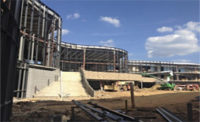“When I sat on that committee, I wanted to make sure that the more than 1,100 school districts in Texas would be able to participate,” Sevcik says. “The small districts that only build a school every 10 to 15 years aren’t going for LEED. They don’t have that kind of money. Texas CHPS allows them to be onboard with sustainability without the added expense.”
Round Rock ISD, just north of Austin, is taking a mixed approach. While the district has committed to pursing LEED-silver on new facilities, it is aiming for CHPS-Designed on its renovations.
The district’s new 375,000-sq-ft Cedar Ridge High School was designed to meet LEED-silver. American Constructors of Austin broke ground on the $78-million project, which was designed by Perkins+Will of Dallas, in May 2008. The project completed in August.
For the $33-million renovation of its Westwood High School, the district is pursuing a CHPS-Designed rating. The project was designed by O’Connell Robertson of Austin and is being built by Bartlett Cocke of San Antonio. Completion is scheduled for summer 2011.
While school districts have multiple choices for rating systems, not all are convinced that certification is necessary. Jeff Haberstroh, facilities engineering cost manager at Central Texas’ Boerne ISD, says that rating systems provide valuable guidance during design and construction, but the value of the review process is questionable.
“We don’t put an emphasis on putting that [rating] plaque on the wall,” he says. “For us, it’s more about taking those dollars and putting them back into the classroom. A $50,000 plaque on the wall does me no good, but $50,000 that can be put into the classroom is helpful.”
In August 2008, the district opened its Samuel V. Champion High School in Boerne. Haberstroh says that although the school does not have an official rating, it was built to achieve LEED-silver certification. A partnership of Pfluger Associates Architects, Austin, and O’Neill Conrad Oppelt Architects, San Antonio, designed the project, which last year was awarded at Texas Environmental Excellence Award for water conservation. The school features a water harvesting system that captures both HVAC system condensate and runoff from the roof and site. The system uses an 800-ft long underground 5-ft diameter storm-water pipe. The total system can hold more than 224,000 gallons of harvested water. The design team estimates a potential savings of $48,000 per year in water costs and the system should pay for itself in less than five years.
“We didn’t spend money on the review, the oversight and the plaque, but we have all the benefits,” Haberstroh adds.
A similar strategy was used on the renovation of the existing Boerne High School, which completed in August 2009.
Beyond the expense, Haberstroh says school districts are leery of getting too attached to a rating system. “It can be a double-edged sword if you put in writing that all buildings must achieve a certain rating,” he adds. “If you do that as a binding resolution, you cross the line into obligating future boards. That’s a legal issue that a lot of boards don’t want to cross.”
Still, many school boards see independent sustainability ratings as a necessity. Humble ISD is pursuing its first LEED and CHPS-Verified project after the completion of Atascocita Springs Elementary School, which opened in August. Deborah Yocham, director of facility planning and construction at Humble ISD, says that getting a project officially verified is not only validating, it’s also a learning opportunity.
“We’re looking for someone else to come in and not only say, ‘You really did meet it and did what you said what you would do,’ but also ‘here’s another way to improve it,’” she says. “If we don’t have someone else come in and help us know what is a better system, then we’ll never improve. We can’t only learn from ourselves.”
Brian Uhlrich, partner at DBR Engineering Consultants and chair of the Green Schools Committee for the USGBC Central Texas Balcones Chapter, says rating systems provide additional credibility in the eyes of constituents. “It proves that [administrators] are being good stewards of taxpayer money and delivering high-performance schools,” he says.
Vittori says that pursuing a certified rating also raises the level of accountability within the build team. “Based on my experience, the level of rigor and seriousness that is taken if not going through the actual certification, is far less. It’s like giving a student a test and then saying, ‘go grade yourself.’ There’s value in third party certification.”







Post a comment to this article
Report Abusive Comment